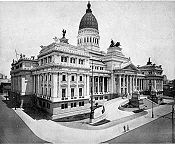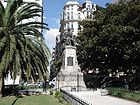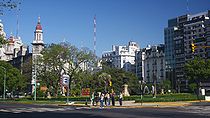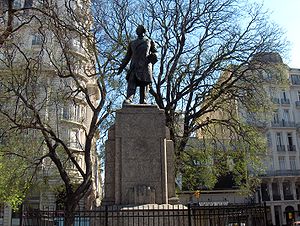
Congressional Plaza
Encyclopedia
Congressional Plaza is a public park facing the Argentine Congress in Buenos Aires. The plaza is part of a 3 hectare (7.5 acre) open space comprising three adjoining plazas to the east of the Congress building. The Kilometre Zero
Kilometre Zero
In many countries, Kilometre Zero or similar terms in other languages, is a particular location , from which distances are traditionally measured...
for all Argentine National Highways is marked on a milestone at the Plaza.
History
Colonial-era businessman Pedro Lorea purchased a 2 hectare (5 acre) lot in the Piety Market Hollow west of the growing hamlet of Buenos Aires in 1782. Lorea later donated around a third of this property for a carriage and cart stop. The Lorea matrimony lost their lives during the failed 1807 British invasions of the Río de la PlataBritish invasions of the Río de la Plata
The British invasions of the Río de la Plata were a series of unsuccessful British attempts to seize control of the Spanish colonies located around the La Plata Basin in South America . The invasions took place between 1806 and 1807, as part of the Napoleonic Wars, when Spain was an ally of...
and, in 1808, Viceroy Rafael de Sobremonte
Rafael de Sobremonte
Don Rafael de Sobremonte y Núñez del Castillo, 3rd Marquis of Sobremonte , third Marquis of Sobremonte, was an aristocrat, military man and Spanish colonial administrator, and Viceroy of the Río de la Plata...
renamed the carriage lot in their honor.
Plaza Lorea retained this function until 1871, when the swamps west of it were drained for development. A flour mill and wholesale market opened in the surroundings and a water tower was installed in the center of the plaza, which became a landscaped public park. The rapid economic growth of late nineteenth century Buenos Aires and the construction of the new Argentine Congress, begun in 1897, helped touch off improvements on Plaza Lorea before work on Congressional Plaza began. Local sculptor Juan Eugenio Boverie graced the plaza's new promenade in 1896 with El Perdón (a sculpture relocated to the westside Avellaneda Park
Avellaneda Park
Avellaneda Park is a public park in the Parque Avellaneda section of Buenos Aires.-Overview:Nearly 5 km west of colonial Buenos Aires , an extensive plot of land was deeded in 1755 to the Brotherhood of the Holy Charity of Jesus Christ, who established an orphanage and the area's largest...
in 1991). Perhaps the most memorable early contribution was the 1907 purchase of one of the few casts of the iconic The Thinker
The Thinker
The Thinker is a bronze and marble sculpture by Auguste Rodin, whose first cast, of 1902, is now in the Musée Rodin in Paris; there are some twenty other original castings as well as various other versions, studies, and posthumous castings. It depicts a man in sober meditation battling with a...
French sculptor Auguste Rodin
Auguste Rodin
François-Auguste-René Rodin , known as Auguste Rodin , was a French sculptor. Although Rodin is generally considered the progenitor of modern sculpture, he did not set out to rebel against the past...
made before he destroyed the mold.

José Figueroa Alcorta
José Figueroa Alcorta was President of Argentina from 12 March 1906 to 12 October 1910.Figueroa Alcorta was born in Córdoba as the son of José Figueroa and Teodosia Alcorta. He was elected a National Representative for Córdoba before becoming Provincial Governor in 1895. In 1898 he returned to the...
signed National Law 6286, a Congressional bill providing for the project. The Municipal Parks Director, French Argentine
French Argentine
A French Argentine is an Argentine citizen of full or partial French ancestry. French Argentines form the third or fourth largest ancestry group after Italian Argentines, Spanish Argentines, and perhaps German Argentines...
urbanist Charles Thays, envisioned a 3 hectare (7.5 acre) space divided crosswise by Montevideo Street and parallel to the Avenida de Mayo
Avenida de Mayo
Avenida de Mayo , is an avenue in Buenos Aires, capital of Argentina. It connects the Plaza de Mayo with Congressional Plaza, and extends in a west-east direction before merging into Avenida Rivadavia.-History and overview:...
(May Avenue). His design was also approved because it required a minimal demolition of existing real estate, as it did not envisage lateral and rear plazas, as urbanist Joseph Bouvard had proposed.
Congressional Plaza was inaugurated in January 1910 by Mayor Manuel Güiraldes and President Figueroa Alcorta. Its inaugural coincided with the completion of numerous other parks, avenues and redevelopments (several of the most important designed by Thays) ahead of the May 25, 1910 centennial of the May Revolution
May Revolution
The May Revolution was a week-long series of events that took place from May 18 to 25, 1810, in Buenos Aires, capital of the Viceroyalty of the Río de la Plata, a Spanish colony that included roughly the territories of present-day Argentina, Bolivia, Paraguay and Uruguay...
, the Buenos Aires assembly whose declaration led to Independence from the Spanish Empire
Spanish Empire
The Spanish Empire comprised territories and colonies administered directly by Spain in Europe, in America, Africa, Asia and Oceania. It originated during the Age of Exploration and was therefore one of the first global empires. At the time of Habsburgs, Spain reached the peak of its world power....
in 1816.
Following a 1967 city ordinance, May Avenue and most other city avenues and streets were made one way thoroughfares. Plaza Lorea, which in 1910 had been divided in two to facilitate traffic from May Avenue, in 1968 had its southern half resigned and added to Mariano Moreno Plaza to facilitate growing traffic further. May Avenue merges into Rivadavia Avenue
Rivadavia Avenue
Avenida Rivadavia is one of the principal thoroughfares in Buenos Aires, Argentina, extending from downtown Buenos Aires to the western suburb of Merlo.-History:...
at this junction.
Overview


Belgium
Belgium , officially the Kingdom of Belgium, is a federal state in Western Europe. It is a founding member of the European Union and hosts the EU's headquarters, and those of several other major international organisations such as NATO.Belgium is also a member of, or affiliated to, many...
sculptor Jules Lagae
Jules Lagae
Jules Lagae was a Belgian sculptor and medallist, born in Roeselare. Lagae was taught by Joseph Jacquet and Charles van der Stappen at the Académie Royale des Beaux-Arts in Brussels. He also worked with Jef Lambeaux and Julien Dillens....
set on a Neoclassical
Neoclassical architecture
Neoclassical architecture was an architectural style produced by the neoclassical movement that began in the mid-18th century, manifested both in its details as a reaction against the Rococo style of naturalistic ornament, and in its architectural formulas as an outgrowth of some classicizing...
esplanade designed by his fellow countryman, architect Henri d'Huicque, and completed in 1914. It was named in honor of the Constitutional Assembly of 1813
Asamblea del Año XIII
The Assembly of Year XIII was a meeting called by the Second Triumvirate governing the young republic of the United Provinces of the Río de la Plata on October 1812....
, the first local attempt to create national law, and the Congress of Tucumán
Congress of Tucumán
The Congress of Tucumán was the representative assembly, initially meeting in Tucumán, that declared the independence of the United Provinces of South America on July 9, 1816, from the Spanish Empire....
of 1816, which declared Independence from the Spanish Empire, and many locals refer to the plaza by that name. The monument's centerpiece, the Allegory of the Republic, and the remaining bronze allegories are set entirely in stone from Nancy, France. The monument is also known for its adjoining terraced fountain and its bronze Neptunes
Neptune (mythology)
Neptune was the god of water and the sea in Roman mythology and religion. He is analogous with, but not identical to, the Greek god Poseidon. In the Greek-influenced tradition, Neptune was the brother of Jupiter and Pluto, each of them presiding over one of the three realms of the universe,...
, the scene of light show
Light show
Light show may refer to:*Aaron Landes* Laser lighting display * Liquid light shows* Christmas lights* Meteor shower* Wizards in Winter Christmas light show...
s and the accompanying music by George Gershwin
George Gershwin
George Gershwin was an American composer and pianist. Gershwin's compositions spanned both popular and classical genres, and his most popular melodies are widely known...
and Jacques Offenbach
Jacques Offenbach
Jacques Offenbach was a Prussian-born French composer, cellist and impresario. He is remembered for his nearly 100 operettas of the 1850s–1870s and his uncompleted opera The Tales of Hoffmann. He was a powerful influence on later composers of the operetta genre, particularly Johann Strauss, Jr....
, early in the 20th century.
Suffering from repeated vandalism in the years since 1983, particularly, a decorative gated fence was erected around the monument in 1999. The opening of the gates by popular demand in 2002 resulted in renewed vandalism, and a new fence was installed in 2006, during renovations on the monument and fountain.


Mariano Moreno
Mariano Moreno was an Argentine lawyer, journalist, and politician. He played a decisive role in the Primera Junta, the first national government of Argentina, created after the May Revolution....
, the intellectual leader of the 1810 May Revolution
May Revolution
The May Revolution was a week-long series of events that took place from May 18 to 25, 1810, in Buenos Aires, capital of the Viceroyalty of the Río de la Plata, a Spanish colony that included roughly the territories of present-day Argentina, Bolivia, Paraguay and Uruguay...
that led to Independence. A monument in his honor was unveiled in 1910. Moreno Plaza is also known for the symbolic "Kilometer Zero" marker put up by the Ministry of Public Works in 1935. Buenos Aires Mayor and Presidential candidate Fernando de la Rúa
Fernando de la Rúa
Fernando de la Rúa is an Argentine politician. He was president of the country from December 10, 1999 to December 21, 2001 for the Alliance for Work, Justice and Education ....
was on hand to unveil a nearby monument to his political mentor, the late centrist UCR
Radical Civic Union
The Radical Civic Union is a political party in Argentina. The party's positions on issues range from liberal to social democratic. The UCR is a member of the Socialist International. Founded in 1891 by radical liberals, it is the oldest political party active in Argentina...
leader Ricardo Balbín
Ricardo Balbín
Ricardo Balbín was an Argentine lawyer and politician, and one of the most important figures of the centrist Radical Civic Union , for which he was the presidential nominee four times: in 1951, 1958, and twice in 1973....
, in 1999. Moreno Plaza is best known to many as the site of one of the few surviving original casts of Auguste Rodin
Auguste Rodin
François-Auguste-René Rodin , known as Auguste Rodin , was a French sculptor. Although Rodin is generally considered the progenitor of modern sculpture, he did not set out to rebel against the past...
's The Thinker
The Thinker
The Thinker is a bronze and marble sculpture by Auguste Rodin, whose first cast, of 1902, is now in the Musée Rodin in Paris; there are some twenty other original castings as well as various other versions, studies, and posthumous castings. It depicts a man in sober meditation battling with a...
. Commissioned by Museums Director Eduardo Schiaffino
Eduardo Schiaffino
Eduardo Schiaffino was an Argentine painter, critic, intellectual and historian. A member of a group known as the Generation of '80, he founded the National Museum of Fine Arts in Buenos Aires and sparked the development of painting in his country.-Biography:Schiaffino was born in Buenos Aires in...
for the city in 1907, he and Rodin had envisaged its placement on a pedestal on the grand steps in front of Congress – a plan which never materialized. Currently, its transfer to its intended site is under consideration.
Less than half its original size, Plaza Lorea is commonly referred to as a plazoleta among locals. The plaza itself is dominated by the monument to José Manuel Estrada
José Manuel Estrada
José Manuel Estrada was a lawyer, writer, Argentinean politician, eminent speaker and representative of Catholic thought.- Biography :...
, a public official known for his opposition to secular education during the late 19th century. The conservative government in power at the time commissioned the monument in 1937, and it was unveiled a decade later.
The three plazas and the Monument to the Two Congresses were designated a National Historic Monument by President Carlos Menem
Carlos Menem
Carlos Saúl Menem is an Argentine politician who was President of Argentina from 1989 to 1999. He is currently an Argentine National Senator for La Rioja Province.-Early life:...
in 1997.

